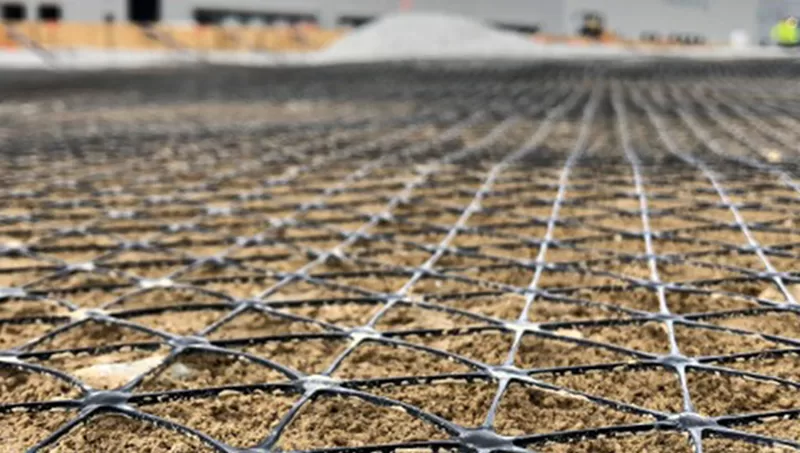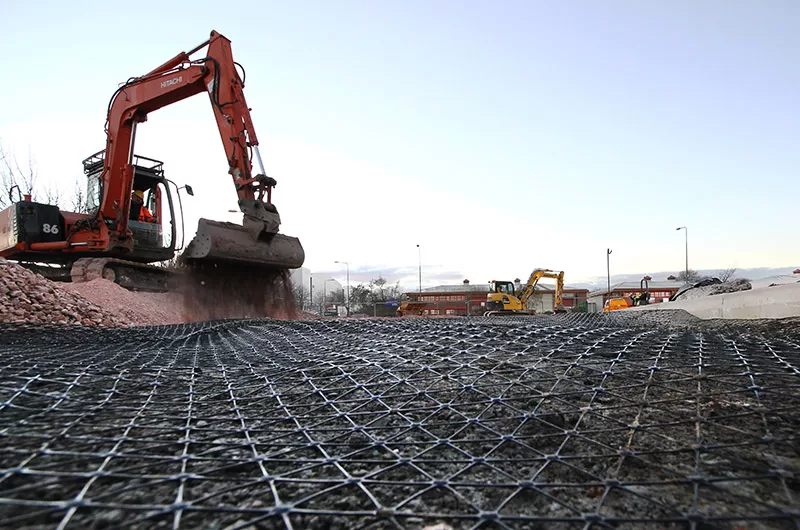+86-159 9860 6917
info@geofantex.com
geofantex@gmail.com
+86-400-8266163-44899
In the ever-evolving field of civil engineering, the quest for more durable, cost-effective, and environmentally friendly construction methods has led to the adoption of innovative materials. Among these, geogrids have emerged as the ideal solution for reinforcing paved roads and aggregate roadways, marking a significant advancement in road construction. This article delves into the essence of geogrids, highlighting their critical application in road construction, the specific role of asphalt geogrids, and the myriad benefits they offer to modern infrastructure projects.

What is a Geogrid Road?
A geogrid road incorporates a geogrid, a geosynthetic material made from polymers such as polypropylene, polyester, or polyethylene, designed with a grid-like structure. This innovative material is specifically designed to interlock with and confine the aggregate, creating a mechanically stabilised layer (MSL) that evenly distributes the load. By reinforcing the road base in this manner, geogrids ensure a more even distribution of loads, significantly increasing the stability and durability of the road surface. Consequently, geogrid roads are renowned for their enhanced performance in a variety of conditions, including areas with soft soils or high traffic loads, showcasing their versatility and effectiveness in modern road construction.
What is the Use of Geogrids in Road Construction?
Geogrids serve a multifaceted role in road construction, primarily used for soil stabilization and reinforcement. By integrating geogrids into the road base or subbase, they not only improve the structural integrity of the road but also provide tensile strength, holding the soils together. This enhancement increases the load-bearing capacity of the soil, reduces rutting, and mitigates the effects of soil movement due to moisture changes. Such applications are particularly beneficial in constructing roads over weak or unstable soils, where traditional construction methods might fail, demonstrating the critical role geogrids play in ensuring the longevity and reliability of road infrastructure.

What is Asphalt Geogrid?
Asphalt geogrid refers to a specific type of geogrid, a geosynthetic material made of polyester geogrid and laminated with ultralight non-woven geotextile, especially designed for asphalt reinforcement. This innovative construction is intended for use within or just below the asphalt layers of a road. Engineered to withstand high temperatures, these geogrids are coated with a bituminous material to enhance their bond with asphalt. The primary function of asphalt geogrids is to reinforce the asphalt layer, effectively reducing the formation of cracks and ruts. Such reinforcement significantly extends the lifespan of the road surface by distributing the stresses caused by traffic loads more evenly across the pavement, ensuring a more durable and reliable roadway.
What are the Benefits of Geogrids?
Geogrids offer a plethora of benefits in road construction, including:
- Longer Service Lives: Roads built with geogrid reinforcement not only exhibit longer service lives but also have good resistance against chemicals, bacteria, and tensile strength, leading to reduced maintenance requirements.
- Cost Efficiency: By enhancing the road’s structural integrity, geogrids can reduce the thickness of required pavement materials, leading to significant cost savings.
- Environmental Sustainability: Geogrids allow for the use of local, less-processed materials and reduce the overall carbon footprint of road construction projects.
- Versatility: Suitable for a wide range of soil types and conditions, geogrids can be used in various projects, from highways to rural roads. Their good resistance against chemicals and bacteria adds to their versatility, making them ideal for diverse environmental conditions.
- Improved Performance: Geogrid-reinforced roads are better equipped to handle heavy traffic loads and adverse weather conditions, ensuring reliable performance over time. The added tensile strength provided by geogrids further enhances this performance, making roads more durable and resilient.
These attributes underscore the significant role geogrids play in modern road construction, offering a sustainable, efficient, and versatile solution for infrastructure development.
Geogrids represent a significant advancement in road construction technology, offering a sustainable, cost-effective, and durable solution for modern infrastructure challenges. By reinforcing soil and asphalt layers, geogrids enhance the performance and longevity of roads, making them an indispensable tool in the civil engineering arsenal. As the construction industry continues to evolve, the role of geogrids in road construction is set to expand, paving the way for more resilient and sustainable road networks worldwide.



Get Free Sample
We’ll respond as soon as possible(within 12 hours)






















